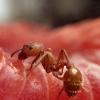Note: please click on images to see full size versions
I've decided to move my journals to here to get a bit more exposure.
As a first time ant keeper I took people's advice from online and got some of the easy to look after ants.
I'd really recommend serafine's introduction to Lasius Niger if you want more information about the species: http://www.formicult...-niger/?p=75525
5th September 2017
My Lasius Niger queen arrived along with my Lasius Flavus queen. She was pretty active from the start and already had a very small pile of eggs/lavae before arriving. Being new to anting I decided to wrap her test tube in red celophane to keep it dark and more natural. I commited to only look in once per week and put her in the warmest room of the house (for international readers - don't worry, the UK isn't that warm).
12th September 2017
Although it's hard to see in the picture below, my new queen has 3 eggs that are steadily growing. She looked to be cleaning them at the time of the photo. Because of the celophane and the dark (I had to use red light to see) it was very hard to tell when the eggs became lavae/pupae, they were just over 1mm long.
19th September
The 3 lavae appeared to have become pupae at this point with a slightly duller casing and being darker inside. Unfortunately I didn't get any photos. Definitely 3 of them.
26th September
When I looked in on the queen I found out all 3 of the pupae had eclosed into nanitics  It seemed so sudden, to go from very little action to having 3 tiny ants running around. They are all very small, probably only 2mm long. They are very fast though in comparision to my other ants, sometimes they move so fast it seems disproportunate to their size.
It seemed so sudden, to go from very little action to having 3 tiny ants running around. They are all very small, probably only 2mm long. They are very fast though in comparision to my other ants, sometimes they move so fast it seems disproportunate to their size.
I gave them a tiny amount of protein jelly and a drop of honey, both of which seemed to be welcomed.
In the picture you can just see two nanitics, one by the queen's head and one below her. It was at this point when she'd raised 3 little nanitics that I decided to call the colony Trinity as all 3 had arrived at the same time.
9th October
The queen had laid some very tiny eggs and I decided to move the test tube into the outworld of a small acrylic formicarium I'd got from Ants Russia. That way I could put a tube in the end and let them explore, which also makes feeding them easier.
You'll also notice that I got out my DSLR to take some better shots, much much better in the dark red light.
14th October
You can really see the queen, 3 nanitics and new brood in this shot. Trinity colony is off to a good start  The formicarium also has water in it and when I put some more protein jelly next to the tube one of the nanitics finds it and starts to feed from it. I also added a few drops of sugar water. They are kept at a steady 26*C.
The formicarium also has water in it and when I put some more protein jelly next to the tube one of the nanitics finds it and starts to feed from it. I also added a few drops of sugar water. They are kept at a steady 26*C.
Sometime after this and before the next update the thermostat breaks for my heat mat and everything shuts down. That's not great as the room all my ants are in is not heated  So they get much colder for a couple of days until the replacement arrives, I also get a second heat mat with a mini-thermostat incase I have any future problems.
So they get much colder for a couple of days until the replacement arrives, I also get a second heat mat with a mini-thermostat incase I have any future problems.
20th October
I had ordered some fruitflies for my colonies, so I put one at the entrance to the exit tube that runs out of the test tube. That disapeared inside over night. Brood still being cared for in the bottom of the tube. I've lowered the temperature to 25*C now as the queen was not always settling on the floor of the test tube, but instead staying on the damp cotton wool. The nanitics are the most active of my ants by a long way, much more active than my C.Barbaricus nanitics that are older, but seem to like standing still in the test tube nearly all the time.
I'm hoping the tiny larae will eclose before hibernation. I'm planning to hibernate them mid-November.
5th November
It's quite hard to see into the test tube at one side as there is some condensation. I edited this to black and white to make it clearer, there is the queen, a couple of workers and some brood under her. I was excited to see that a 4 worker has eclosed and is now running around with the rest. It's hard to tell how many eggs and brood there are as some seem to be on the cottonwool.
I moved them up further from the heat mat, which has dropped the temperature to around 22*C, but the queen is still hugging the cotton most of the time. I guess it may just be a humidity thing. I moved the test tube to a new outworld & formicarium that had just arrived from China. I'm really pleased with it, only issue is that it doesn't come with hydration outside the nest, but great value for money and lots of space in the nest - which seems important for these guys as L.Niger colonies are supposed to grow fast. Here's the new set up:
12th November
They've been busy, they now have 5 workers  It's taken me a couple of days to get a good shot with them all in. There are also 2 pupae, so I'm wondering if they will eclose before the end of the month. These guys really aren't showing any signs of hibernation. I've also taken the red celophane away as well and they seem to be happy living in the daylight. If they aren't happy they will hopefully move into the new nest that I've covered with red and black on opposite sides, we'll see...
It's taken me a couple of days to get a good shot with them all in. There are also 2 pupae, so I'm wondering if they will eclose before the end of the month. These guys really aren't showing any signs of hibernation. I've also taken the red celophane away as well and they seem to be happy living in the daylight. If they aren't happy they will hopefully move into the new nest that I've covered with red and black on opposite sides, we'll see...
Edited by Dreamer, December 31 2017 - 3:34 PM.

































